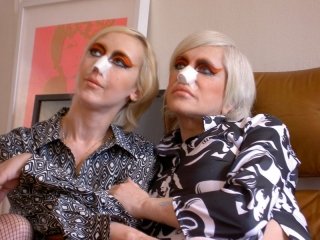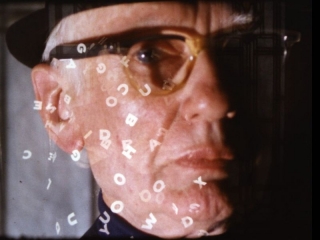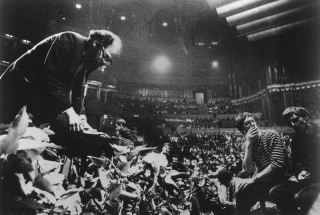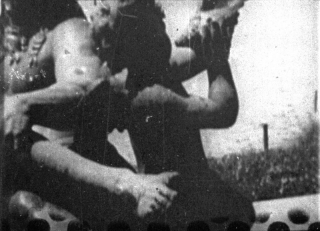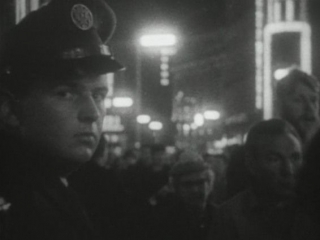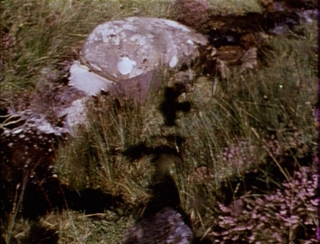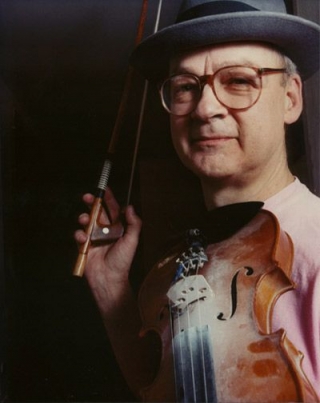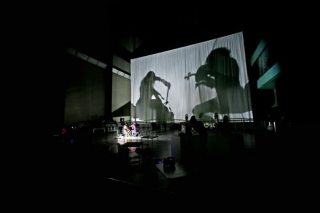Date: 20 November 2007 | Season: The Wire 25
EXTRAORDINARY LIVES
London Roxy Bar and Screen
Tuesday 20 November 2007, at 8pm
Luke Fowler’s Bogman Palmjaguar is a portrait of its namesake, a former patient of radical psychologist R.D. Laing who now lives a hermetic life in the Flow Country of the Scottish Highlands. Documenting the environment of the surrounding landscape as much as its human focus, the images are accompanied by Lee Patterson’s evocative field recordings. Genesis P-Orridge and Lady Jaye are the subjects of Marie Losier’s diary/documentary, which pursues the pandrongynous partners at home, visiting MoMA’s Dada exhibition, and on tour with Thee Majesty and Throbbing Gristle.
Luke Fowler, Bogman Palmjaguar, UK, 2007, 30 min
Marie Losier, A Ballad with Genesis P-Orridge and Lady Jaye, France-USA, 2007, 37 min
PROGRAMME NOTES
EXTRAORDINARY LIVES
London Roxy Bar and Screen
Tuesday 20 November 2007, at 8pm
BOGMAN PALMJAGUAR
Luke Fowler, UK, 2007, video, colour, sound, 30 min
“Bogman Palmjaguar is a portrait of a man who after a series of disturbing events became distrustful of people and withdrew into nature. Bogman describes himself as ‘the hidden cat’ and ‘wild outlaw of paradise’ and is fighting against a diagnosis that that brands him as a ‘paranoid schizophrenic’. Bogman’s early life, and the diagnosis, subsequently conditioned his relationships with others, both within and beyond the medical establishment. The decision to take legal action to remove this label is of paramount importance to him, both as a search for justice and to seek reason in the course his life has taken over the past three decades. The film was shot across two visits to Bogman’s home in a remote village in the north of Scotland. The former was motivated by Bogman’s solicitor’s request of an independent report by Dr. Leon Redler (author and college of R. D. Laing), to assess whether the label ‘paranoid schizophrenic’ was justified. The latter was in collaboration with sound artist Lee Patterson, documenting the environment which Bogman sought to preserve during his time as a conservationist. Bogman had been passionate about the threatened habitat of Scotland’s Flow Country; a wilderness made of blanket bogs and peatlands that houses a unique diversity of wildlife. However the peatlands also became a hide-out, when Bogman fled attempts to section him. The film is a reconciliation of the young conservationist with his older self; isolated and withdrawn from society.” (Luke Fowler)
A BALLAD WITH GENESIS P-ORRIDGE AND LADY JAYE
Marie Losier, USA, 2007, video, colour, sound, 37 min
“I met Genesis by accidentally treading on her feet. I was at an opening in Soho, one of those where you can barely walk and breath and I ended up on her toes. I turned around to apologize and there she was, staring at me smiling with all her golden teeth glittering in my eyes. That’s where it all started. For a while we emailed, learning about each other more and more and one day I ended up in her house, sitting on a giant plastic green chair in the shape of a hand. Since that day I’ve been, in a way, adopted by the family of mom and pop, as Genesis and Lady Jaye call themselves, and by the whole Psychic TV3 band. I’ve been filming them at their home, waking up and going through the routine of being Pandrogynes, which is their main art work today: it’s a living performance in a way. They’ve been having plastic surgery to resemble one another, or rather to be closer to each other in order to break the binary system of male/female, good/bad … creating a third identity that is free from the rules of society. It’s been now a year since I started shooting: they took me on tour in Europe with them, to film them on the routine of the tour. My camera and myself have been totally invited to their life at the rehearsals with the whole band, at home with their favourite person, their dog, Big Boy, with friends, their daughters, going through their incredibly busy daily lifestyles between recording albums, preparing concerts, being in three bands, making art pieces for gallery shows, writing books, doing a raw food diet, shopping for mini skirts, cleaning, and growing their garden in their Bushwick house … there is a lot more I need to capture, but what you will see now is a sort of love ballad for them.” (Marie Losier)
Back to top
Date: 7 March 2008 | Season: Gregory Markopoulos 2008 | Tags: Gregory Markopoulos, Markopoulos
GREGORY J. MARKOPOULOS
7—8 March 2008
London Tate Modern
Gregory J. Markopoulos (1928–1992) was a key figure in the evolution of the New American Cinema of the 1960s, an archetypal personal filmmaker who counted Jack Smith, Kenneth Anger, Stan Brakhage and Maya Deren amongst his contemporaries. His ravishing films are a complex combination of masterful camerawork and editing with a strong vision rooted in myth and poetry.
As his reputation reach its peak, Markopoulos rejected the independent film movement and relocated from New York to Europe in 1967. There, he planned the construction of an archive and projection space – The Temenos – on a remote site in the Greek countryside, a setting that would be in harmony with his extraordinary films.
In his later years, he meticulously edited his life’s work, incorporating over 100 individual titles, into an 80-hour long silent film for presentation only at his chosen location in Arcadia. Since Markopoulos’ death in 1992, the filmmaker Robert Beavers (himself the subject of a Tate Modern retrospective in February 2007) has been working towards the final printing and exhibition of this unique work. The screenings of the first two sections (“orders”) of ENIAIOS took place in 2004 and were commemorated in articles in Artforum, Frieze and Film Comment.
PORTRAITS OF ARTISTS: Friday 7 March 2008
THE ILLIAC PASSION: Saturday 8 March 2008
This rare opportunity to view a selection of Markopoulos’ films in London anticipates TEMENOS 2008; the free, open-air premieres of ENIAIOS III-V that will take place close to the village of Lyssaraia on 27-29 June 2008.
The Tate Modern screenings are curated by Stuart Comer and Mark Webber, and will be introduced by Robert Beavers.
Back to top
Date: 7 March 2008 | Season: Gregory Markopoulos 2008 | Tags: Gregory Markopoulos, Markopoulos
MARKOPOULOS: PORTRAITS OF ARTISTS
Friday 7 March 2008, at 7pm
London Tate Modern
Markopoulos made many extraordinary film portraits, which often incorporate an activity or object that has personal significance to the subject. This programme presents a selection of poetic and sensuous portraits of cultural and art world luminaries such as Gilbert & George, Alberto Moravia, Giorgio di Chirico and Rudolph Nureyev.
Gregory J. Markopoulos, Through A Lens Brightly: Mark Turbyfill, USA, 1967, 15 min
Portrait of Mark Turbyfill
Gregory J. Markopoulos, Eniaios (Order III, Reel 1) (Gibraltar), Switzerland, 1975, 15 min
Portrait of Gilbert & George
Gregory J. Markopoulos, Eniaios (Order IV, Reel 6) (The Olympian), Italy, 1969, 23 min
Portrait of Alberto Moravia
Political Portraits (excerpt)
Gregory J. Markopoulos, Europe, 1969, 15 min
Portraits of Ulrich Herzog, Marcia Haydee, Rudolph Nureyev, Giorgio di Chirico
Gregory J. Markopoulos, Eniaios (Order II, Reel 2), Europe, undated, 23 min
Portraits of Hans-Jakob Siber, Franco Quadri, Giorgio Frapoli, Klaus Schönherr and family
“The films preserve the myriad flights of isolated, spectrally splintered and itinerant spirit, lost in yearning, in search of intuitive wholeness while negotiating mazes of desire, seeking sanctuary in the reflection of countless identities. The works hold a shimmering mirror up to the contradictory compulsions of an era, set to register, for a few instants, shocks of recognition.” (Kirk Winslow, Millennium Film Journal)
The screening will be introduced by Robert Beavers.
Back to top
Date: 25 May 2008 | Season: Videoex 2008
COUNTERCULTURE: LONDON IN THE SIXTIES
Sunday 25 May 2008, at 12pm
Zurich Videoex Festival Cinema Z3
After The Beatles shook the nation out of the cultural dark ages, Swinging London was the place to be. Prompted by the example of the American Beats, English experimenters and creative rebels challenged the conventions of art, music, literature, filmmaking and society itself.
The Boyle Family, Poem for Hoppy, 1967, 16mm on video, colour, sound, 4 min
Peter Whitehead, Wholly Communion, 1965, 16mm, b/w, sound, 32 min
Antony Balch & William Burroughs, Towers Open Fire, 1963, 16mm, b/w & colour, sound, 16 min
John Latham, Speak, 1968-69, 16mm, sound, colour, 11 min
James Scott, Richard Hamilton, 1969, 16mm, colour, sound, 25 min
PROGRAMME NOTES
COUNTERCULTURE: LONDON IN THE SIXTIES
Sunday 25 May 2008, at 12pm
Zurich Videoex Festival Cinema Z3
POEM FOR HOPPY
The Boyle Family, 1967, 16mm on video, colour, sound, 4 min
An improvised performance by Soft Machine and the Sensual Laboratory at the legendary UFO Club, in protest against John Hopkins’ excessive conviction for marijuana possession. (MW)
WHOLLY COMMUNION
Peter Whitehead, 1965, 16mm, b/w, sound, 32 min
The International Poetry Incarnation at the Royal Albert Hall started London’s sixties adventure. Whitehead’s crisply shot, half-hour film is remarkably comprehensive in documenting key performances of the evening, and captures the tangible sense of expectation that must have permeated the atmosphere within the cavernous concert hall. Wholly Communion not only encapsulates this seminal moment in which the underground went public, but remains one of the few records of a whole generation of poets performing in their prime. (MW)
TOWERS OPEN FIRE
Antony Balch, 1963, 16mm, colour, sound, 16 min
Envisioned as a cinematic realisation of Burroughs’ key themes such as the breakdown in control, the film contains rapid editing, flicker, strobing and extreme jump cuts that interrupt the narrative flow. The British Censor requested removal of some offensive language from the soundtrack but passed (or failed to recognise) the shots of Balch masturbating, and of Burroughs shooting up. (MW)
SPEAK
John Latham, 1968-69, 16mm, sound, colour, 11 min
Speak is his second attack on the cinema. Not since Len Lye’s films in the thirties has England produced such a brilliant example of animated abstraction. Speak burns its way directly into the brain. It is one of the few films about which it can truly be said, ‘it will live in your mind’. (Raymond Durgnat)
RICHARD HAMILTON
James Scott, 1969, 16mm, colour, sound, 25 min
Devoid of authoritative voiceover, the film presents samples of the artist’s work alongside reference materials, found footage, scenes from Hollywood features and news reports of the notorious Rolling Stones drugs trial. Bing Crosby, Marilyn Monroe and Patricia Knight (in Sirk and Fuller’s long forgotten Shockproof) also make appearances as the film traces the inspiration behind some of Hamilton’s signature paintings. (MW)
Back to top
Date: 27 May 2008 | Season: Videoex 2008 | Tags: Shoot Shoot Shoot
SHOOT SHOOT SHOOT: 1
Tuesday 27 May 2008, at 6pm
Zurich Videoex Festival Cinema Z3
The London Film-Makers’ Co-operative was established in 1966 to support work on the margins of art and cinema. It uniquely incorporated three related activities within a single organisation – a workshop for producing new films, a distribution arm for promoting them, and its own cinema space for screenings. In this environment, Co-op members were free to explore the medium and control every stage of the process. The Materialist tendency characterised the hardcore of British filmmaking in the early 1970s. Distinguished from Structural Film, these works were primarily concerned with duration and the raw physicality of the celluloid strip.
Annabel Nicolson, Slides, 1970, colour, silent, 11 mins (18fps)
Guy Sherwin, At the Academy, 1974, b/w, sound, 5 mins
Mike Leggett, Shepherd’s Bush, 1971, b/w, sound, 15 mins
David Crosswaite, Film No. 1, 1971, colour, sound, 10 mins
Lis Rhodes, Dresden Dynamo, 1971, colour, sound, 5 mins
Chris Garratt, Versailles I & II, 1976, b/w, sound, 11 mins
Mike Dunford, Silver Surfer, 1972, b/w, sound, 15 mins
Marilyn Halford, Footsteps, 1974, b/w, sound, 6 mins
PROGRAMME NOTES
SHOOT SHOOT SHOOT: 1
Tuesday 27 May 2008, at 6pm
Zurich Videoex Festival Cinema Z3
SLIDES
Annabel Nicolson, 1970, colour, silent, 11 mins (18fps)
“A continuing sequence of tactile films were made in the printer from my earlier material. 35mm slides, light leaked film, sewn film, cut up to 8mm and 16mm fragments were dragged through the contact printer, directly and intuitively controlled. The films create their own fluctuating colour and form dimensions defying the passive use of ‘film as a vehicle’. The appearance of sprocket holes, frame lines etc., is less to do with the structural concept and more of a creative, plastic response to whatever is around.” (Annabel Nicolson, LFMC catalogue 1974)
AT THE ACADEMY
Guy Sherwin, 1974, b/w, sound, 5 mins
“Makes use of found footage hand printed on a simple home-made contact printer, and processed in the kitchen sink. At The Academy uses displacement of a positive and negative sandwich of the same loop. Since the printer light spills over the optical sound track area, the picture and sound undergo identical transformations.” (Guy Sherwin, LFMC catalogue 1979)
SHEPHERD’S BUSH
Mike Leggett, 1971, b/w, sound, 15 mins
“Shepherd’s Bush was a revelation. It was both true film notion and demonstrated an ingenious association with the film-process. It is the procedure and conclusion of a piece of film logic using a brilliantly simple device; the manipulation of the light source in the Film Co-op printer such that a series of transformations are effected on a loop of film material. From the start Mike Leggett adopts a relational perspective according to which it is neither the elements or the emergent whole but the relations between the elements (transformations) that become primary through the use of logical procedure.” (Roger Hammond, LFMC catalogue supplement, 1972)
FILM NO. 1
David Crosswaite, 1971, colour, sound, 10 mins
“Film No. 1 is a 10-minute loop film. The systems of super-imposed loops are mathematically inter-related in a complex manner. The starting and cut off points for each loop are not clearly exposed, but through repetitions of sequences in different colours, in different ‘material’ realities (i.e. a negative, positive, bas-relief, neg-pos overlay) yet in constant rhythm (both visually and on the soundtrack hum) one is manipulated to attempt to work out the system structure … The film deals with permutations of material, in a prescribed manner but one by no means ‘necessary’ or logical (except within the film’s own constructed system/serial.)” (Peter Gidal, LFMC catalogue 1974)
DRESDEN DYNAMO
Lis Rhodes, 1971, colour, sound, 5 mins
“This film is the result of experiments with the application of Letraset and Letratone onto clear film. It is essentially about how graphic images create their own sound by extending into that area of film which is ‘read’ by optical sound equipment. The final print has been achieved through three separate, consecutive printings from the original material, on a contact printer. Colour was added, with filters, on the final run. The film is not a sequential piece. It does not develop crescendos. It creates the illusion of spatial depth from essentially, flat, graphic, raw material.” (Tim Bruce, LFMC catalogue 1993)
VERSAILLES I & II
Chris Garratt, 1976, b/w, sound, 11 mins
”For this film I made a contact printing box, with a printing area 16mm x 185mm which enabled the printing of 24 frames of picture plus optical sound area at one time. The first part is a composition using 7 x 1-second shots of the statues of Versailles, Palace of 1000 Beauties, with accompanying soundtrack, woven according to a pre-determined sequence. Because sound and picture were printed simultaneously, the minute inconsistencies in exposure times resulted in rhythmic fluctuations of picture density and levels of sound. Two of these shots comprise the second part of the film which is framed by abstract imagery printed across the entire width of the film surface: the visible image is also the sound image.” (Chris Garratt, LFMC catalogue 1978)
SILVER SURFER
Mike Dunford, 1972, b/w, sound, 15 mins
“A surfer, filmed and shown on tv, refilmed on 8mm, and refilmed again on 16mm. Simple loop structure preceded by four minutes of a still frame of the surfer. An image on the borders of apprehension, becoming more and more abstract. The surfer surfs, never surfs anywhere, an image suspended in the light of the projector lamp. A very quiet and undramatic film, not particularly didactic. Sound: the first four minutes consists of a fog-horn, used as the basic tone for a chord played on the organ, the rest of the film uses the sound of breakers with a two second pulse and occasional bursts of musical-like sounds.” (Mike Dunford, LFMC catalogue supplement 1972)
FOOTSTEPS
Marilyn Halford, 1974, b/w, sound, 6 mins
“Footsteps is in the manner of a game re-enacted, the game in making was between the camera and actor, the actor and cameraman, and one hundred feet of film. The film became expanded into positive and negative to change balances within it; black for perspective, then black to shadow the screen and make paradoxes with the idea of acting, and the act of seeing the screen. The music sets a mood then turns a space, remembers the positive then silences the flatness of the negative.” (Marilyn Halford, LFMC catalogue 1978)
Back to top
Date: 30 May 2008 | Season: Videoex 2008
SOCIAL WORKS: NEW DOCUMENTARY FORMS
Friday 30 May 2008, at 4pm
Zurich Videoex Festival Cinema Z3
Long before the celebrated ‘Free Cinema’ movement of the 1950s, British-based filmmakers were advancing the documentary form through innovative styles and techniques. Beginning with a hilariously absurd travelogue from 1924, this programme traces that development through good times and bad, resolute with humour and irony.
Adrian Brunel, Crossing the Great Sagrada, 1924, 35mm, tinted b/w, sound, 10 min
Arthur Elton & E.H. Anstey, Housing Problems, 1935, 35mm, b/w, sound, 13 min
Stefan & Franciszka Themerson, Calling Mr Smith, 1943, 35mm, colour, sound, 10 min
Len Lye, N or NW, 1938, 35mm, b/w, sound, 8 min
Charles Ridley, Germany Calling, 1941, 16mm, b/w, sound, 2 min
Claude Goretta & Alan Tanner, Nice Time, 1957, 16mm, b/w, sound, 17 min
John Bennett, Papercity, 1969, 35mm, colour, sound, 5 minutes
PROGRAMME NOTES
SOCIAL WORKS: NEW DOCUMENTARY FORMS
Friday 30 May 2008, at 4pm
Zurich Videoex Festival Cinema Z3
CROSSING THE GREAT SAGRADA
Adrian Brunel, 1924, 35mm, tinted b/w, sound, 10 min
The film is a humorous spoof of a travelogue. Travel films were popular in the Twenties, documenting foreign cultures in a way that tended to reflect imperial, nationalist and often racist stereotypes. Brunel sends up many of the conventions of the genre familiar to audiences. (Jamie Sexton)
HOUSING PROBLEMS
Arthur Elton & Edgar Anstey, 1935, 35mm, b/w, sound, 13 min
A watershed in British documentary making. For the first time ordinary people spoke directly to the camera about their plight. The clumsy sound-recording equipment (packed into a truck parked outside the locations in Stepney) enabled the directors to achieve huge impact by filming the slum dwellers as they described life inside their wretched houses. The film was made to promote the use of gas as a clean and modern fuel by associating it with the throwing out of the old and the building of the new. (FourDocs)
CALLING MR SMITH
Stefan & Franciszka Themerson, 1943, 35mm, colour, sound, 10 min
The Themersons call on ‘Mr Smith’ to support the war effort as an anti-fascist struggle, illustrating its appeal with examples of Nazi oppression in Poland. The film is experimental in technique, using anamorphic lenses, still and moving images and vivid colour. While the spoken soundtrack employs a rhetoric heard elsewhere in wartime propaganda, the overall tone of the film is unusually urgent and authentic and in some sequences, images combine with music (Chopin, Szymanowski) to convey a real feeling of loss. (David Finch)
N or N.W.
Len Lye, 1938, 35mm, b/w, sound, 8 min
In N or N.W., Lye began to work with more conventionally ‘dramatic’ material. The film, advertising the benefits of writing letters and using the postal system, centred on a simple narrative of lovers at cross-purposes who are eventually reunited. Yet Lye used a number of unconventional edits, extreme close-ups, trick shots and superimposed animation in order to take a creative approach to such a conventional theme. (Jamie Sexton)
GERMANY CALLING
Charles Ridley, 1941, 35mm, b/w, sound, 2 min
A remarkable piece of British wartime propaganda which ridicules Nazi Germany by manipulating footage of Hitler, his party officials and troops of goose stepping soldiers. All are subjected to the optical humiliation of being made dance to the ‘The Lambeth Walk’, a song that the Nazi party branded as ‘Jewish mischief and animalistic hopping.’ (MW)
NICE TIME
Claude Goretta & Alan Tanner, 1957, 16mm, b/w, sound, 17 min
Impressions of Piccadilly Circus in 1957: hot dogs and nude magazines; dumb cinema queues; posters advertising the glories of war and the horrors of science fiction; lonely faces; searching glances; the parade of amateur and professional ‘talent’; presiding over all, the ironic statue of Eros … The observation is untouched by nostalgia, and presents a devastating picture for anyone who thinks of Piccadilly Circus in romantic terms. (Monthly Film Bulletin)
PAPERCITY
John Bennett, 1969, 35mm, colour, sound, 5 min
Papercity builds an impressionistic portrait of London through still photographs and time-lapse footage. Views of the city rarely feature in experimental films of this period, but this semi-commercial production, funded by the British Film Institute, is an evocative study of everyday sights and activities. (MW)
Back to top
Date: 31 May 2008 | Season: Videoex 2008 | Tags: Shoot Shoot Shoot
SHOOT SHOOT SHOOT: 2
Saturday 31 May 2008, at 6pm
Zurich Videoex Festival Cinema Z3
The 1960s and 1970s were a defining period for artists’ film and video in which avant-garde filmmakers challenged cinematic convention. In England, much of the innovation took place at the London Film-Makers’ Co-operative, an artist-led organisation that incorporated a distribution office, projection space and film workshop. Despite the workshop’s central role in production, not all the work derives from experimentation in printing and processing. Filmmakers also used language, landscape and the human body to create less abstract works that still explore the essential properties of the film medium.
Malcolm Le Grice, Threshold, 1972, colour, sound, 10 mins
Chris Welsby, Seven Days, 1974, colour, sound, 20 mins
Peter Gidal, Key, 1968, colour, sound, 10 mins
Stephen Dwoskin, Moment, 1968, colour, sound, 12 mins
Gill Eatherley, Deck, 1971, colour, sound, 13 mins
William Raban, Colours of this Time, 1972, colour, silent, 3 mins
John Smith, Associations, 1975, colour, sound, 7 mins
PROGRAMME NOTES
SHOOT SHOOT SHOOT: 2
Saturday 31 May 2008, at 6pm
Zurich Videoex Festival Cinema Z3
THRESHOLD
Malcolm Le Grice, 1972, colour, sound, 10 mins
“Le Grice no longer simply uses the printer as a reflexive mechanism, but utilises the possibilities of colour-shift and permutation of imagery as the film progresses from simplicity to complexity … With the film’s culmination in representational, photographic imagery, one would anticipate a culminating ‘richness’ of image; yet the insistent evidence of splice bars and the loop and repetition of the short piece of found footage and the conflicting superimposition of filtered loops all reiterate the work which is necessary to decipher that cinematic image.” (Deke Dusinberre, LFMC catalogue 1993)
SEVEN DAYS
Chris Welsby, 1974, colour, sound, 20 mins
“The location of this film is by a small stream on the northern slopes of Mount Carningly in southwest Wales. The seven days were shot consecutively and appear in that same order. Each day starts at the time of local sunrise and ends at the time of local sunset. One frame was taken every ten seconds throughout the film. The camera was mounted on an Equatorial Stand, which is a piece of equipment used by astronomers to track the stars. Rotating at the same speed as the earth, the camera is always pointing at either its own shadow or at the sun. Selection of image (sky or earth; sun or shadow) was controlled by the extent of cloud coverage. If the sun was out the camera was turned towards its own shadow; if it was in the camera was turned towards the sun.” (Chris Welsby, LFMC catalogue 1978)
KEY
Peter Gidal, 1968, colour, sound, 10 mins
“Slow zoom out and defocus of …” (Peter Gidal, LFMC catalogue 1974)
MOMENT
Stephen Dwoskin, 1968, colour, sound, 12 mins
“One single continuous shot of a girl’s face before, during and after an orgasm. A concentration on the subtle changes within the face – going from an objective look into a subjective one and then back out … Moment is not a woman alone, but with her ‘in person’. Have you ever really watched the face in orgasm?” (Stephen Dwoskin, Other Cinema catalogue 1972)
DECK
Gill Eatherley, 1971, colour, sound, 13 mins
“During a voyage by boat to Finland, the camera records three minutes of black and white 8mm film of a woman sitting on a bridge. The preoccupation of the film is with the base and with the transformation of this material, which was first refilmed on a screen where it was projected by multiple projectors at different speeds and then secondly amplified with colour filters, using positive and negative elements and superimposition on the London Co-op’s optical printer.” (Gill Eatherley, Light Cone catalogue, 1997)
COLOURS OF THIS TIME
William Raban, 1972, colour, silent, 3 mins
“Whilst working on previous time-lapse films, I found that colour film tended to record the actual colour of the light source rather than local colour when long time exposures were used. Using this phenomenon, Colours of this Time records all the imperceptible shifts of colour temperature in summer daylight, from first light until sunset.” (William Raban, LFMC catalogue 1974)
ASSOCIATIONS
John Smith, 1975, colour, sound, 7 mins
“Text taken from ‘Word Associations and Linguistic Theory’ by Herbert H. Clark. Images taken from magazines and colour supplements. By using the ambiguities inherent in the English language, Associations sets language against itself. Image and word work together/against each other to destroy/create meaning.” (John Smith, LFMC catalogue 1978)
Back to top
Date: 1 June 2008 | Season: Videoex 2008
LONDON ON AND ON II: SURFACE STRUCTURES
Sunday 1 June 2008, at 4pm
Zurich Videoex Festival Cinema Z3
Exploring the surface of the film strip, the surface of the earth and the structures that make up cinematic movement, the programme begins with an overwhelming barrage and ends with a sliver of carpaccio. Between those extremes, time-lapse films survey the landscape or atmosphere and John Smith directs the flow of traffic.
Greg Pope, Shadow Trap, 2007, 35mm cinemascope, colour, sound, 8 min
Nicky Hamlyn, Water Water, 2005, 16mm, b/w & colour, silent, 11 min
William Raban, Continental Drift, 2005, 35mm, colour, sound, 15 min
John Smith, Worst Case Scenario, 2003, video, b/w & colour, sound, 18 min
Alix Poscharsky, As We All Know, 2006, 16mm cinemascope, colour, silent, 8 min
Emma Hart, Skin Film 3, 2006, 16mm, colour, sound, 11 min
PROGRAMME NOTES
LONDON ON AND ON II: SURFACE STRUCTURES
Sunday 1 June 2008, at 4pm
Zurich Videoex Festival Cinema Z3
SHADOW TRAP
Greg Pope, 2007, 35mm cinemascope, colour, sound, 8 min
Shards of emulsion produced during the auto-destructive film performance Light Trap have been layered and structured onto clear 35mm. Extending across the soundtrack area, the synaesthetic image creates an intense volley of sound and light. (MW)
WATER WATER
Nicky Hamlyn, 2005, 16mm, b/w & colour, silent, 11 min
Water Water is based around a set of antinomies that operate at various levels, from between frames to between the two halves of the film. The first is composed of individually filmed frames (animation) which form shots of interlaced contrary motion. In the second half, dissolves replace cuts, light softens and contrast decreases. (NH)
CONTINENTAL DRIFT
William Raban, 2005, 35mm, colour, sound, 15 min
A land and sea-scape film drawn from rich sources of imagery: the constantly changing mood of the sea to the distinctly different shorelines of Kent and the Pas de Calais – 21 miles of water that define both the ‘island race’ and hostility towards a wider integration within Europe. (WR)
WORST CASE SCENARIO
John Smith, 2003, video, b/w & colour, sound, 18 min
Worst Case Scenario looks down onto a busy Viennese intersection and a corner bakery. Constructed from hundreds of still images, it presents situations in a stilted motion, often with sinister undertones. Through this technique we’re made aware of our intrinsic capacity for creating continuity, and fragments of narrative, from potentially (no doubt actually) unconnected events. (MW)
AS WE ALL KNOW
Alix Poscharsky, As We All Know, 2006, 16mm cinemascope, colour, silent, 8 min
Referencing science fiction, this film is about the discrepancy between scientific world view and everyday life. We know the earth is moving round the sun, but viewed from earth the sun appears to be moving round the earth. This film poses the question whether knowing (or ‘seeing’) is not just another form of believing, as, ultimately, what is shown in the film, is merely earth’s rotations around its own axis. (AP)
SKIN FILM 3
Emma Hart, 2003/06, 16mm, colour, sound, 11 min
By sticking Sellotape to my skin and then peeling it off, I took off the top surface of my skin. I then stuck the tape and the skin to clear 16mm film. It is my actual skin that goes through the projector. It is a film of my total surface area. From head to toe. (EH)
Back to top
Date: 13 June 2008 | Season: Tony Conrad | Tags: Tony Conrad
TONY CONRAD
13—15 June 2008
London Tate Modern
Tony Conrad is a pivotal figure in contemporary culture. His multi-faceted contributions since the 1960s have influenced and redefined music, filmmaking, minimalism, performance, video and conceptual art. Known for his groundbreaking film The Flicker, his involvement in the Theatre of Eternal Music and the evolution of the Velvet Underground, and collaborations with a host of luminaries including Jack Smith, John Cale, Mike Kelley and Henry Flynt, Conrad remains a radical figure who challenges our understanding of art history. This special weekend at Tate Modern will feature a major new performance for the Turbine Hall and screenings of Conrad’s extraordinary film and video work.
Curated by Stuart Comer, Alice Koegel and Mark Webber. Assistant Curator Vanessa Desclaux.
With thanks to Galerie Daniel Buchholz, Cologne; Ed Carter, Lumen/Evolution; Tracey Ferguson; Florian Härle; Tony Herrington, The Wire; Branden W. Joseph; Christophe Kniel and Ilja Mess; Neil Lagden; Elliot Landy; David Leister; Marie Losier; Eric Namour, [no.signal]; Jay Sanders, Greene Naftali Gallery, New York; Chloë Stewart; Ann Twiselton, MIT Press; Steve Wald; Richard Whitelaw, Sonic Arts Network.
INTRODUCTION
TONY CONRAD
Friday 13 – Sunday 15 June 2008
London Tate Modern
Tony Conrad is a pivotal, polymath figure in contemporary culture, a pioneering composer, musician, performer and filmmaker, whose work emerged at the heart of New York’s fervent avant-garde art community in the early 1960s. Best known for his influential early musical explorations and the ‘experiential excess’ of his groundbreaking ‘structural film’, The Flicker, Conrad’s work offers a complex reassessment of duration and temporality, and a direct implication of the viewer as an active participant in his work. His hybrid, often perceptually intense practice has persistently expanded disciplinary boundaries and challenged traditional notions of authorship and authority for more than forty years.
After studying mathematics at Harvard, during the early 1960s Conrad developed a distinct approach to sound in contemporary musical production, introducing sustained drones built upon a strategy of minimal reduction and temporal expansion. From 1962 he was a key member of the groundbreaking Theatre of Eternal Music (also known as The Dream Syndicate). The group developed ‘Dream Music’ which dispensed with written scores and critiqued the history of western orchestral performance. Utilising long durations, precise pitch and blistering volume, its members – including Conrad, La Monte Young, Marian Zazeela and future Velvet Underground co-founders John Cale and Angus MacLise – forged a performance collaboration which denied the activity of composition, examined the physical elements of sound, and established a principal branch of the minimalist tradition. Following the dissolution of the group in 1965, Conrad has continued to reflect on duration as a concept in various fields conventionally distinguished as music, film, performance and the visual arts, always challenging his audience in whatever medium he employs.
Throughout his career Conrad has sought ‘physiological and psychological phenomena’ that produce a profound interaction with the audience. The stroboscopic, psychedelic intensity of films like The Flicker and the saturated energy and long duration of Conrad’s music can become powerful, moving and unsettling experiences that heighten awareness both of the physical experience of the event and of one’s own subjectivity within it. Carrying over from one medium to another, Conrad sets up situations that encourage free experiences of audiovisual perception and perceptual engagement, ‘manufacturing the culture as the event proceeds, as the context sustains.’
Much of Conrad’s work has involved collaboration, from the Theatre of Eternal Music to his involvement with the philosopher, musician and anti-art activist Henry Flynt, his early creative partnership with the underground artist and filmmaker Jack Smith, his participation in the influential Department of Media Study at the State University of New York at Buffalo, and more recent projects with artists such as Mike Kelley and Tony Oursler. As his career has shifted and intersected with these diverse artists, agendas and positions, Conrad has problematised not only his own work but the conventional set of categories used to contain and define it. A reconsideration of his practice also problematises traditional linear histories of the movements and developments with which he has been associated: minimalism, Fluxus, early conceptualism, underground and structural film, paracinema or expanded cinema, performance and video. The heterogeneous nature of Conrad’s work comprises a radical and productive inconsistency that continues to subvert the power structures that regulate the writing of history.
Conrad’s approach to cinema reflects his penchant for transcending boundaries and reconfiguring conventional notions of production. The Flicker, his rallying call for a new age of cinema, led the philosopher Gilles Deleuze to muse on a ‘cinema of expansion without camera, and also without screen or film stock,’ a cinema in which ‘anything can be used as a screen, the body of a protagonist or even the bodies of the spectators; anything can replace the film stock, in a virtual film which now only goes on in the head, behind the pupils.’ Conrad’s films do not rely only on luminous, audiovisual stimulation and extreme perceptual states. He has also explored a wide range of unusual materials and production methods, experimenting with various ways of cooking film – treating raw film stock as an ingredient to be stir-fried or pickled, and then projected. He has also played film as a musical instrument, stretched taut and played upon with a bow, and has used a Tesla coil to electrocute film stock.
This theatrical, performative approach to creating films makes process and production an integral and evident part of the work. The relationships between process, projection and performance have a long history within Conrad’s work and take on particular resonance in Early Minimalism, a series of compositions which refer to and redress the artist’s history with the Theatre of Eternal Music. Performances take place behind a scrim, backlit to create shadows of the performers, a spectral doubling to complicate the work’s relationship to the past.
Unprojectable: Projection and Perspective, a new commission in which Conrad addresses the immense space of Tate Modern’s Turbine Hall with its central bridge as a stage, exposes us to his most recent exploration of projection and long duration on a major scale. A tremendous sound will fill the Turbine Hall, starting off with a buzzing pulse at 25 per second, mixed with an amplified string quartet including Conrad on violin, an electric drill and hand-held phonograph arms. Billowing scrims on either side of the bridge function as projection screens for the performative activities enacted behind them. These actions will include the live music performance and re-enactments of alternative film production processes Conrad developed in the mid-1970s, such as drilling holes in raw film stock. While the audience occupies the floor below, Conrad’s back-projected, larger-than-life silhouette will loom large, swaying in response to the production of sounds which will generate a pressure-filled auditory environment. The intensity of the sound will ground the event in the physical and perceptual space of the present, while the shadows might be read as a comment on the status of the present versus the re-presented and non-recoverable past in the archive of musical and visual culture.
—Stuart Comer, Tate Modern, Curator: Film
—Alice Koegel, Tate Modern, Curator: Contemporary Art and Performance
Back to top
Date: 14 June 2008 | Season: Tony Conrad | Tags: Tony Conrad
UNPROJECTABLE: PROJECTION AND PERSPECTIVE
Saturday 14 June 2008, at 10pm
London Tate Modern
This major new live performance by Tony Conrad is especially conceived for the latent sound and immense scale of the Turbine Hall. Emerging from an installation inspired by the hum of the former power station’s one remaining generator, Conrad’s sonic and visual feast will incorporate an amplified string quartet, electric drill and motors, phonograph arms, film projection and shadows which loom high above the audience.
Conceived and performed by Tony Conrad.
MV Carbon, cello
Tony Conrad, violin
Angharad Davies, violin
Dominic Lash, bass
Steve Wald, production manager
Delta Sound, sound design
Chloë Stewart, projection
This is a free event as part of UBS Openings: Saturday Live.
Back to top
